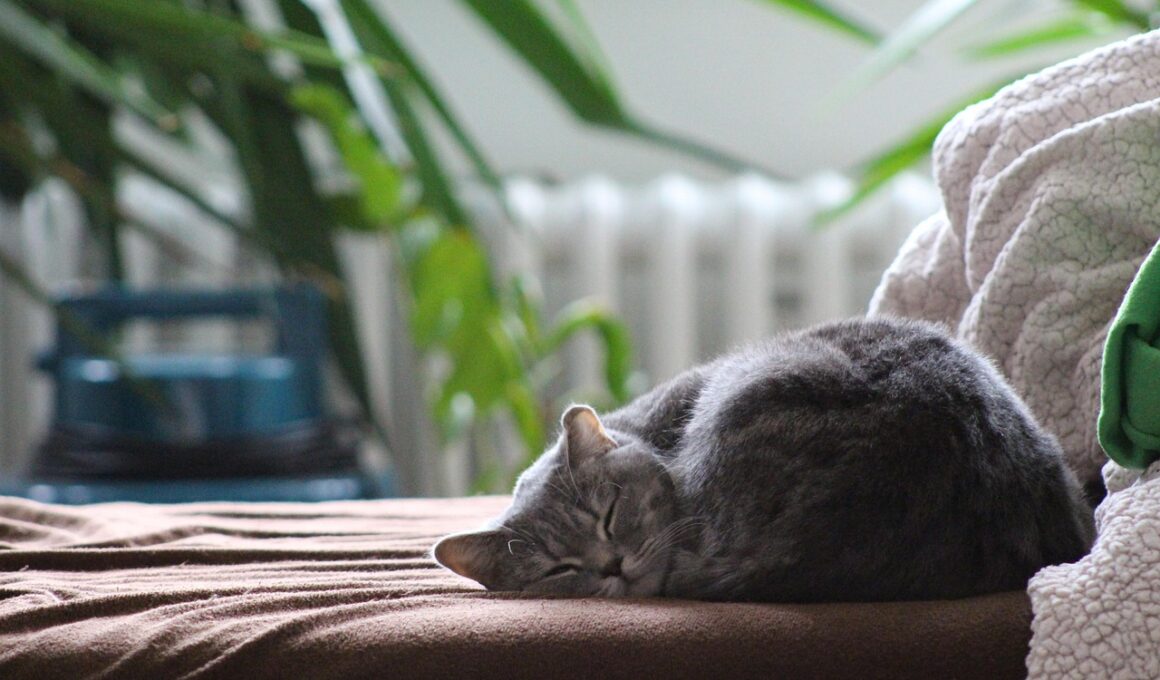Understanding Calming Commands for Cats
Cats can be anxious creatures, and understanding calming commands is crucial for every cat owner. These commands help to soothe and comfort your feline friends during stressful situations. It is essential to create a serene environment where the cat feels secure. Training your cat to respond to specific commands aids in establishing a gentle routine that can significantly reduce anxiety levels. Utilizing calm tones and consistent actions when issuing these commands is key. Over time, your cat will associate commands with positive experiences, such as treats or gentle petting. This association reinforces learning and promotes a tranquil atmosphere. To integrate these calming commands into daily interactions, try simple phrases such as “easy” or “relax” while stroking their favorite spots. Moreover, providing a safe space is vital; consider reserving a cozy corner with calming scents, like lavender. Always remember that patience and positive reinforcement are fundamental. By enforcing these techniques, you not only help your cat feel more at ease but also strengthen the bond you share. Additionally, consider consulting resources or professionals if needed.
Importance of Calming Commands
Understanding the importance of calming commands is essential for effective cat care. When your cat exhibits signs of stress, such as hiding or vocalizing excessively, employing specific commands can ease their anxiety. These techniques promote a sense of security and comfort. Effective communication through voice and body language becomes even more significant. Commands must be simple and intuitive, facilitating your cat’s understanding. Implementing commands encourages positive behavior while discouraging anxiety-driven actions. Such commands can include soft phrases or sounds. Gradually, your cat learns to associate your voice with safety, responding positively in tense situations. It’s beneficial to practice these commands regularly, creating a routine that reinforces their effectiveness. Also, environments should be clutter-free and peaceful, conducive to relaxation. Calming techniques do not yield immediate results; similar to dogs, cats require time to adapt and learn. Regular interaction ensures that your commands remain effective, establishing a bond built on trust and safety. Moreover, employing techniques simultaneously with physical comfort—like gentle petting—strengthens emotional support, enhancing the commands’ calming effects.
Commonly used commands can serve as effective tools for providing reassurance to your cat. Some of the most helpful phrases to incorporate consistently include words like “gentle” or “slow.” Pairing these commands with calming actions, such as slow petting or soft brushing, creates positive experiences. Cats are sensitive to both tone and pitch, so speaking softly during these interactions matters. Reinforcement following successful responses upon hearing commands encourages repetition, further embedding the behavior. Over time, as cats learn the meanings behind the words and the reassuring context, they can adjust more readily to stressors around them. Integrating calming commands requires patience and consistency; rewarding your cat for compliance with treats or praise emphasizes the positive experience associated with the command. Later on, these responses help to shape a more relaxed demeanor. Owners should identify triggers that lead to anxiety and practice commands in those specific situations, preparing their pets for potential stressors ahead of time. Training sessions can be brief yet frequent, ensuring that the lessons remain manageable and enjoyable. Gradually, this familiarizes the cat with their environment and they ultimately learn to trust their owners.
Situations Where Calming Commands Are Needed
Recognizing situations where calming commands are necessary can better prepare owners. Common scenarios include vet visits, thunderstorms, or meeting new people. Each of these situations can elicit anxiety; using calming commands becomes crucial in navigating them effectively. When your cat faces stressful environments, the ability to perform learned commands provides both immediate and long-term benefits for the cat’s mental health. As an immediate response during a tense moment, issuing the command and providing a safe retreat option can help the animal feel more in control. Establishing a calm environment through commands beforehand can significantly minimize anxiety. It is beneficial to practice calming commands in a variety of contexts to reinforce behaviors. Training should happen in quiet moments, potentially capitalizing on periods of downtime or relaxation. Regular exposure helps your cat generalize the calming commands to less predictable circumstances. These preparations ensure your cat knows which actions to expect, lowering their stress response when faced with troublesome situations. Moreover, owners can create a familiar and consistent response pattern that reassures the cat during times of unease.
To enhance the effectiveness of calming commands, integrating additional techniques can be beneficial. Utilizing pheromone diffusers or comforting sounds, like soft music, can complement the verbal commands well. Establishing a calming routine further amplifies the security felt by your cat, as they become accustomed to predictability in their environment. Each element of the routine—the verbal command, the actions of the owner, and the atmosphere—works cohesively. By ensuring other areas of the cat’s care align with calming practices, enhancement becomes an everyday norm. This could involve arranging cozy resting spots, providing engaging but calming toys, or designating times for quiet bonding. Furthermore, considering your cat’s individual personality traits allows for personalized approaches to calmness. Some cats respond better to visual cues, while others might react to tactile stimulation. Tailoring your methods to suit your pet increases the chances of successful comfort. Formulating a tailored plan equips owners to effectively address specific anxiety triggers, optimizing the calming process overall. This personalized strategy will ultimately assist in building a stable relationship between the cat and owner, fostering deeper trust.
Patience and Consistency
Employing calming commands isn’t instantaneous; patience and consistency are key elements in this learning process. Each cat has a unique learning pace, and recognizing this is essential for establishing a positive experience. Owners must remain aware of the signs their cats display, allowing them the necessary space to adjust. Perfection is not the goal; even minor progress can be considered success. Consistency in utilizing calming commands fosters trust over time, as the cat learns what to expect during interactions. Training sessions should be kept short and engaging to maintain the cat’s interest. Positive reinforcement remains a critical aspect, as cats often learn by association. Providing treats, affection, or playtime when the cat responds to calming commands further solidifies the lessons. Even if progress feels slow at first, patience will ultimately yield results, enriching the bond between owner and cat. Over time, the combination of commands, gentle practices, and an understanding approach creates a foundation of calm. The gradual success affirms the commitment being made to their well-being. Ultimately, your cat’s comfort and trust lead to a more harmonious relationship.
In conclusion, mastering calming commands for cats is an essential skill for pet owners. The benefits of these techniques extend not only to enhancing day-to-day interactions but also contribute to long-term mental health improvements for your feline companions. Remember that stress can manifest in various forms, from anxiety during new experiences to unexpected disruptions. Therefore, being prepared with calming commands equips you to face challenges head-on. Through understanding the importance of these commands, recognizing stressful situations, and ensuring a consistent routine, you will facilitate a more relaxed environment. Moreover, patience will cultivate trust and security between you and your cat. Employing these strategies fosters harmony within your home while increasing the well-being of your beloved pet. The commitment to practicing calming techniques brings forth an enriched quality of life for both cats and their owners. Whether your cat is timid, anxious, or simply needs reassurance, these commands provide comfort. Keep learning and remain observant, adjusting your techniques and approaches to best suit your cat’s needs. Ultimately, you have the power to transform your cat’s experience and nurture their wellbeing.


